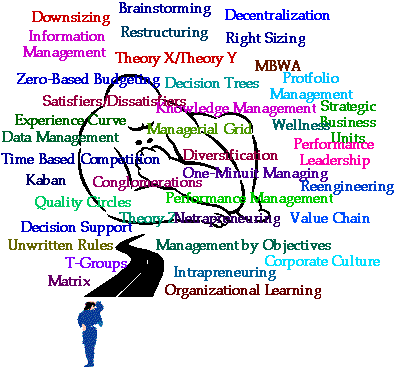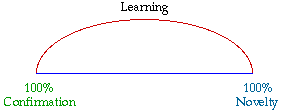The Knowledge Centered Organization
A Dream Quest
Organizations have but a few basic difficulties. These difficulties
just happen to masquerade behind a plethora of facades which ensures
that most perceive their number to be legion. The apparent legion
of difficulties can be distilled down to just four areas:
- Objectives: well defined, communicated, understood,
and committed to
- Demand: commensurate with the level of capacity of
the organization
- Capacity: adequate to meet the current and projected
demands
- Effectiveness: extent to which the organization promotes
demand, and manages capacity to respond to the demand on its
journey toward its objectives.
This list may strike you as a bit short, so if you can think
of an organizational difficulty that doesn't fit in one of these
categories please let me know and we'll see if it really should
be an addition.
The four areas above map just happen to map quite nicely to
Mike Davidson's[1] for areas of organizational
concern:
- Mission: What are we trying to accomplish?
- Competition: How do we gain a competitive edge?
- Performance: How do we deliver the results?
- Change: How do we cope with change?
Now if the puzzle is definable in such straight forward and
apparently simple terms, why is it that organizations have such
ongoing difficulties attempting to put the pieces together? The
difficulty stems from a single foundation, or lack thereof, knowledge.
The problems people experience within organizations stem from
two knowledge dimensions:
- What they don't know they don't know, and
- What they think they know that just happens to be wrong.
As for what they know, and what they know they don't know,
the former is the basis for appropriate action, and the latter
can be accommodated through learning. As for the two dimensions
listed above the first doesn't create nearly as many problems
as the latter because the latter forms the basis for inappropriate
action. Inappropriate action which simply leads to more difficulties
for the organization to deal with.
Over the years a whole host of approaches, more methodologies
if you prefer wordiness, have been developed to assist organizations
through their difficulties. The diagram below is my attempt at
providing a humorous perspective regarding these approaches.
Microsoft asks, "Where
do you want to go today?"

Asking how you're going to get there is also
a good question! |
That these approaches have helped many organizations sort of
goes without saying, otherwise they never would have become fads
now would they. Yet, many other organizations just couldn't figure
out how to get the mileage out of an approach so they blamed the
failure on the approach and moved on to the next one. Do you get
the impression there is something a bit warped in this picture?
We seems to have this passion for formulas, and when an individual,
group, or organization experiences extraordinary success there
is often an attempt to explain how that success was achieved.
Of course, if we did it once then we should be able to do it again,
right? All we need to know is the formula. Here's a paradigm for
failure if I've ever seen one, but it sells well, as Tony Robbins,
Steven Covey, Phil Crosby, Tom Peters, Michael Hammer, Peter Senge,
and a host of others can attest to.
This is not to imply that the formulas don't have dimensions
of merit. They all do. It's just that none of them are complete.
And all of them taken together does not represent completeness
either. There are just too many variables to be reduced to some
simple n-step formula. And if this is the case, then how is it
that success is achieved?
Success happens when a group of capable individuals pursue
a well defined objective, continually reassessing things along
the way, sometimes even questioning the continued sensibility
of the objective, making adjustments based on the feedback, and
pressing on. And here's where knowledge, and knowledge management[2] becomes such a valuable component of success.
When we deal with a situation we do so based on all that we
bring with us. All the experience real or imagined that makes
us what we are. And the extent to which the pattern of the situation
connects governs our actions and the timing of those actions.
Eric Jantsch[4] used the following diagram
with regard to communication and I think it also quite relevant
regarding how we deal with situations.

The idea being that situations we experience represent something
on the scale from 100% Confirmation to 100% Novelty and it is
the situations we deal with between these two extremes from which
we learn. Those situations which represent 100% Confirmation provide
nothing new and are just dealt with. Those situations which represent
100% Novelty we are completely unable to deal with because we
are unable to make any connection.
References
- [1] Davidson, Mike. The Transformation
of Management. Butterworth-Heinman. 1996
- [2] Bellinger, Gene. Knowledge
Management. 1997
- [3] Bellinger, Gene. The
Effective Organization. 1997
- [4] Jantsch, Eric. The Self-Organizing
Universe: Scientific and Human Implications. Pergamon Press.
1980
theWay of Systems
* Feedback
* Musings
Copyright © 2004 Gene Bellinger
|

